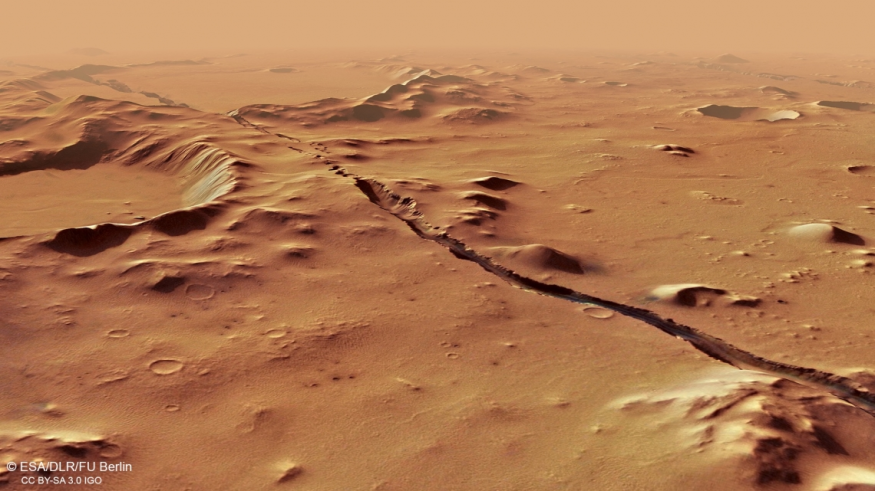Many people have believed that Mars is a "dead" planet with a static interior because it lacks the shifting tectonic plates that reshape Earth's surface. However, a new study published in the journal Nature Astronomy suggests that this may not be the case. Scientists from the University of Arizona have discovered evidence of an active mantle plume beneath the surface of Mars, which is causing earthquakes and volcanic eruptions and pushing the surface upward. This finding indicates that Mars may have a more active and dynamic interior than previously believed, despite its seemingly calm exterior.
According to Adrien Broquet, a researcher at the University of Arizona's Lunar and Planetary Laboratory, and Jeff Andrews-Hanna, an associate professor of planetary science at the same institution, there is strong evidence for the existence of an active mantle plume on Mars.
Mantle plumes are large, warm, and buoyant rock formations that rise from deep inside a planet and push through its mantle layer to reach the base of its crust, causing earthquakes, faulting, and volcanic eruptions. These processes are typically associated with planets like Earth and Venus, but the presence of an active mantle plume on Mars is unexpected because the planet is small and thought to be relatively cold.

Giant Mantle Plumes Indication
The study's authors say that the findings suggest that Mars may still be geologically active, although the planet was most active 3 to 4 billion years ago and is generally considered to be "dead" today. According to the researchers, Mars has a history of significant volcanic activity that resulted in the formation of the tallest volcanoes in the solar system and the deposition of volcanic material across much of the northern hemisphere. More recently, however, volcanic activity on Mars has been relatively rare and is generally thought to be the result of passive processes on a cooling planet.
The researchers were particularly interested in a region of Mars called Elysium Planitia, which is located within the northern lowlands near the equator. Unlike other volcanic regions on Mars that have not seen major activity for billions of years, Elysium Planitia has experienced significant eruptions over the past 200 million years, including the youngest known volcanic eruption on the planet, which occurred around 53,000 years ago.
They also found that the majority of Mars' "marsquakes" or earthquakes originate from a region called Cerberus Fossae, a set of fissures that stretch for more than 800 miles across the Martian surface. Until now, the cause of this young volcanic and tectonic activity in Elysium Planitia was unknown.

ALSO READ : Massive Hidden Mantle Plume on Mars Is Driving Intense Volcanic and Seismic Activity on the Red Planet
Potential Seismic Activities
On Earth, volcanism and earthquakes are often associated with either mantle plumes or plate tectonics. Mantle plumes, which can be thought of as hot blobs of material rising through the mantle layer of a planet, typically cause a sequence of events that includes the uplifting and stretching of the crust, the eruption of molten rock as flood basalts, and the creation of vast volcanic plains. When the researchers studied the features of Elysium Planitia on Mars, they found evidence of this same sequence of events.
The surface of the region has been uplifted by more than a mile, and measurements of the gravity field and the tilting of impact crater floors suggest that this uplift is being supported from deep within the planet, consistent with the presence of a mantle plume. When the researchers applied a tectonic model to the area, they found that the only way to explain the extension responsible for the formation of the Cerberus Fossae was the presence of a giant mantle plume that is 2,500 miles wide. This finding suggests that Mars may have a more active and dynamic interior than previously thought.
Elysium Planitia on Mars is exhibiting characteristics that are typically associated with an active mantle plume, according to Adrian Broquet. This presents a challenge for models used to study the thermal evolution of planets and will require future studies to consider the presence of a very large mantle plume that was not previously anticipated. The area affected by the mantle plume is roughly the same size as the United States.
The discovery of an active mantle plume on Mars is significant because it changes our understanding of the planet's geologic evolution and could potentially have implications for the possibility of life on Mars. The region where the plume is located has a history of liquid water flooding, the cause of which has previously been unknown. The heat from the plume, which is driving ongoing volcanic and seismic activity, could also melt ice and potentially create conditions suitable for sustaining life underground.
Check out more news and information on Mars in Science Times.
© 2025 ScienceTimes.com All rights reserved. Do not reproduce without permission. The window to the world of Science Times.











